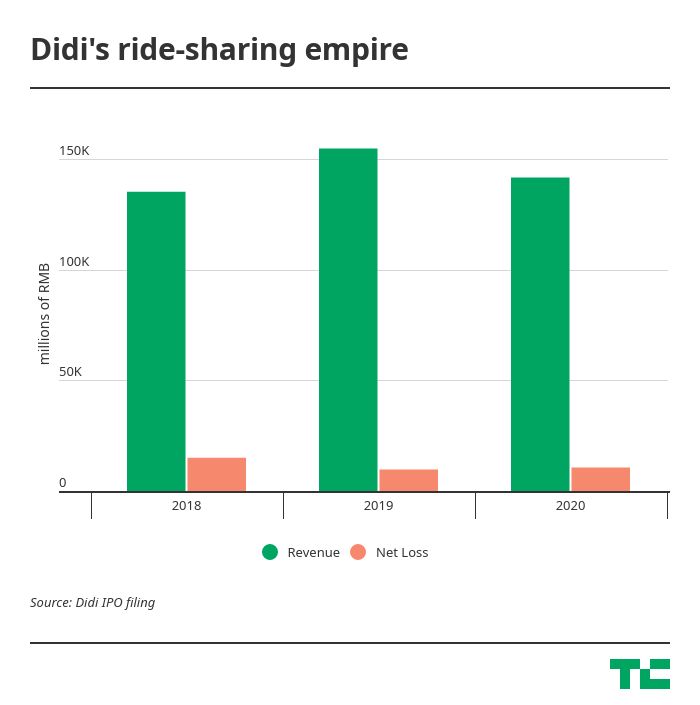After years of speculation, Didi Chuxing, China’s ride-sharing behemoth, finally unveiled its IPO filing in the U.S., giving a glimpse into its money-losing history.
Didi didn’t disclose the size of its raise. Reuters reported the company could raise around $10 billion at a valuation of close to $100 billion, though The Wall Street Journal cited a valuation upward of $70 billion. Uber’s market cap currently exceeds $90 billion.
Cheng Wei, Didi’s 38-year-old founder owns 7% of the company’s shares and controls 15.4% of its voting power before the IPO, according to the prospectus. Major shareholders to reap returns are SoftBank Vision Fund, which owns 21.5% of the company, Uber with 12.8% and Tencent at 6.8%.
The nine-year-old company, which famously acquired Uber’s China operations in 2016, is more than a ride-hailing platform now. It has a growing line of businesses like bike-sharing, grocery, intra-city freight, financial services for drivers, electric vehicles and Level 4 robotaxis, which it defines as “the pinnacle of our design for future mobility” for its potential to lower costs and improve safety.
Didi set up an autonomous driving subsidiary that banked $500 million from SoftBank’s second Vision Fund in May last year. The unit now operates a team of over 500 members and a fleet of over 100 autonomous vehicles. It’s also designing EVs for ride-hailing as China pushes taxis and ride sharing companies to phase out fossil fuel vehicles.
Market dominance
For the twelve months ended March, Didi served 493 million annual active users and saw 41 million transactions on a daily basis. It had 156 million monthly users in Q1, well above Uber’s 98 million in the period.
China’s official data showed the country had 365 million ride hailing users as of December, which suggests Didi commands a substantial market share.
Mobility services in China have consistently accounted for over 90% of Didi’s revenues. The company has tried to expand its presence in a dozen overseas countries like Brazil, where it bought local ride-hailing business 99 Taxis. And more than 97% of Didi’s China-based mobility revenues — which also include taxi hailing, chauffeur and carpooling, a lucrative business that was revamped following two deadly accidents — came from ride-hailing between 2018 and 2020.

Third-party data also speaks to Didi’s dominance. Aurora Mobile, an app tracking firm, showed that Didi had 77.6 million active users in March. Its closest rival Geely-backed Caocao was less than one-tenth of its size.
Didi had been operating in the red from 2018 to 2020, when it finished the year with a $1.6 billion net loss, but managed to turn the tide in the first quarter of 2021 by racking up a net profit of $837 million. It noted that the increased profit was primarily due to investment income from the deconsolidation of Chengxin, its cash-burning grocery group buying initiative, and an equity investment disposal.
Revenue from Q1 also more than doubled year-over-year to $6.6 billion. Uber, in comparison, racked up $2.9 billion in revenue for the period.
Didi plans to spend 30% of its IPO proceeds on shared mobility, electric vehicles, autonomous driving and other technologies. 30% will go towards its international expansion and another 20% will be used for new product development.
Powered by WPeMatico






